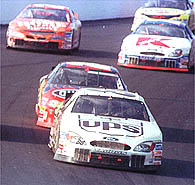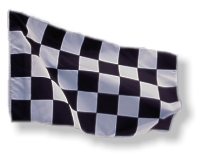
A WebQuest for 6th Grade (Math, Writing, Technology) Designed by Nathan Crowder [email protected]
Introduction | Task | Process | Evaluation | Conclusion | Credits | Teacher Page Okay NASCAR fans!!! Get ready to start your engines. Today, you will become part of a racing team and learn about a specific famous race track. As a team you will use math, writing and technology to complete your research. In the end, we'll celebrate what you have learned! So tighten your seatbelts and get ready for the ride of your life!
By the time you finish this ride of your life, you will know more about how different team members of a racing team work together to make everything come together. When you have finished collecting the data on each specific race track and performing your required analysis on it, then each group will come together to discuss with all the other groups what they have learned about their respective track. This will be a raceday celebration at which you will put everything you have together to try to convice the other groups that your track is the best track in the entire Nascar series. Each group will have 3 members with each member performing a different task on the required track. Each group will be assigned a different track. One member will research the statistical aspects of each track. One member will research the history of the track and what has occured there in the past. The final group member will create a brochure, that advertises the track and what kinds of attractions surround the track and why someone would want to visit this track. Get ready for the adventure of a lifetime!!!!!
To accomplish the task, what steps should the learners go through? Use the numbered list format in your web editor to automatically number the steps in the procedure. Describing this section well will help other teachers to see how your lesson flows and how they might adapt it for their own use, so the more detail and care you put into this, the better. Remember that this whole document is addressed to the student, however, so describe the steps using the second person.
In the Process block, you might also provide some guidance on how to organize the information gathered. This advice could suggestions to use flowcharts, summary tables, concept maps, or other organizing structures. The advice could also take the form of a checklist of questions to analyze the information with, or things to notice or think about. If you have identified or prepared guide documents on the Web that cover specific skills needed for this lesson (e.g. how to brainstorm, how to prepare to interview an expert), link them to this section.
There will be a common grade for the entire group, so make sure you do your part!
Hopefully now you have learned a great deal about racing. You have also been able to see the different aspects of a particular race track and what kinds of things make a racetrack different from the other racetracks. Do you see how you may be able to use web resources to learn about anything that interests you in the future? Hopefully you have enjoyed working together as a group and now have a few tools to use on future projects that you didn't have before doing this webquest. Congratulations, you are a true champion. The checkered flag is yours!
List here the sources of any images, music or text that you're using. Provide links back to the original source. Say thanks to anyone who provided resources or help. List any books and other analog media that you used as information sources as well.
|

